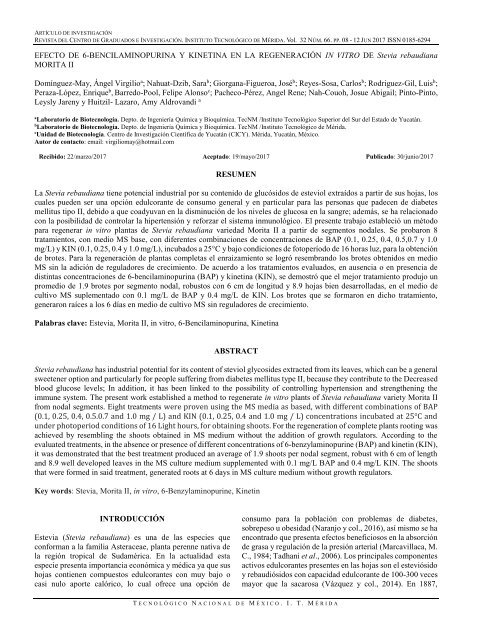You also want an ePaper? Increase the reach of your titles
YUMPU automatically turns print PDFs into web optimized ePapers that Google loves.
ARTÍCULO DE INVESTIGACIÓN<br />
REVISTA DEL CENTRO DE GRADUADOS E INVESTIGACIÓN. INSTITUTO TECNOLÓGICO DE MÉRIDA. Vol. <strong>32</strong> NÚM. <strong>66</strong>. PP. 08 - 12 JUN 2017 ISSN 0185-6294<br />
EFECTO DE 6-BENCILAMINOPURINA Y KINETINA EN LA REGENERACIÓN IN VITRO DE Stevia rebaudiana<br />
MORITA II<br />
Domínguez-May, Ángel Virgilio a ; Nahuat-Dzib, Sara b ; Giorgana-Figueroa, José b ; Reyes-Sosa, Carlos b ; Rodriguez-Gil, Luis b ;<br />
Peraza-López, Enrique b , Barredo-Pool, Felipe Alonso c ; Pacheco-Pérez, Angel Rene; Nah-Couoh, Josue Abigail; Pinto-Pinto,<br />
Leysly Jareny y Huitzil- Lazaro, Amy Aldrovandi a<br />
a Laboratorio de Biotecnología. Depto. de Ingeniería Química y Bioquímica. TecNM /Instituto Tecnológico Superior del Sur del Estado de Yucatán.<br />
b Laboratorio de Biotecnología. Depto. de Ingeniería Química y Bioquímica. TecNM /Instituto Tecnológico de Mérida.<br />
c Unidad de Biotecnología. Centro de Investigación Científica de Yucatán (CICY). Mérida, Yucatán, México.<br />
Autor de contacto: email: virgiliomay@hotmail.com<br />
Recibido: 22/marzo/2017 Aceptado: 19/mayo/2017 Publicado: 30/junio/2017<br />
RESUMEN<br />
La Stevia rebaudiana tiene potencial industrial por su contenido de glucósidos de esteviol extraídos a partir de sus hojas, los<br />
cuales pueden ser una opción edulcorante de consumo general y en particular para las personas que padecen de diabetes<br />
mellitus tipo II, debido a que coadyuvan en la disminución de los niveles de glucosa en la sangre; además, se ha relacionado<br />
con la posibilidad de controlar la hipertensión y reforzar el sistema inmunológico. El presente trabajo estableció un método<br />
para regenerar in vitro plantas de Stevia rebaudiana variedad Morita II a partir de segmentos nodales. Se probaron 8<br />
tratamientos, con medio MS base, con diferentes combinaciones de concentraciones de BAP (0.1, 0.25, 0.4, 0.5,0.7 y 1.0<br />
mg/L) y KIN (0.1, 0.25, 0.4 y 1.0 mg/L), incubados a 25°C y bajo condiciones de fotoperíodo de 16 horas luz, para la obtención<br />
de brotes. Para la regeneración de plantas completas el enraizamiento se logró resembrando los brotes obtenidos en medio<br />
MS sin la adición de reguladores de crecimiento. De acuerdo a los tratamientos evaluados, en ausencia o en presencia de<br />
distintas concentraciones de 6-bencilaminopurina (BAP) y kinetina (KIN), se demostró que el mejor tratamiento produjo un<br />
promedio de 1.9 brotes por segmento nodal, robustos con 6 cm de longitud y 8.9 hojas bien desarrolladas, en el medio de<br />
cultivo MS suplementado con 0.1 mg/L de BAP y 0.4 mg/L de KIN. Los brotes que se formaron en dicho tratamiento,<br />
generaron raíces a los 6 días en medio de cultivo MS sin reguladores de crecimiento.<br />
Palabras clave: Estevia, Morita II, in vitro, 6-Bencilaminopurina, Kinetina<br />
ABSTRACT<br />
Stevia rebaudiana has industrial potential for its content of steviol glycosides extracted from its leaves, which can be a general<br />
sweetener option and particularly for people suffering from diabetes mellitus type II, because they contribute to the Decreased<br />
blood glucose levels; In addition, it has been linked to the possibility of controlling hypertension and strengthening the<br />
immune system. The present work established a method to regenerate in vitro plants of Stevia rebaudiana variety Morita II<br />
from nodal segments. Eight treatments were proven using the MS media as based, with different combinations of BAP<br />
(0.1, 0.25, 0.4, 0.5.0.7 and 1.0 mg / L) and KIN (0.1, 0.25, 0.4 and 1.0 mg / L) concentrations incubated at 25°C and<br />
under photoperiod conditions of 16 Light hours, for obtaining shoots. For the regeneration of complete plants rooting was<br />
achieved by resembling the shoots obtained in MS medium without the addition of growth regulators. According to the<br />
evaluated treatments, in the absence or presence of different concentrations of 6-benzylaminopurine (BAP) and kinetin (KIN),<br />
it was demonstrated that the best treatment produced an average of 1.9 shoots per nodal segment, robust with 6 cm of length<br />
and 8.9 well developed leaves in the MS culture medium supplemented with 0.1 mg/L BAP and 0.4 mg/L KIN. The shoots<br />
that were formed in said treatment, generated roots at 6 days in MS culture medium without growth regulators.<br />
Key words: Stevia, Morita II, in vitro, 6-Benzylaminopurine, Kinetin<br />
INTRODUCCIÓN<br />
Estevia (Stevia rebaudiana) es una de las especies que<br />
conforman a la familia Asteraceae, planta perenne nativa de<br />
la región tropical de Sudamérica. En la actualidad esta<br />
especie presenta importancia económica y médica ya que sus<br />
hojas contienen compuestos edulcorantes con muy bajo o<br />
casi nulo aporte calórico, lo cual ofrece una opción de<br />
consumo para la población con problemas de diabetes,<br />
sobrepeso u obesidad (Naranjo y col., 2016), así mismo se ha<br />
encontrado que presenta efectos beneficiosos en la absorción<br />
de grasa y regulación de la presión arterial (Marcavillaca, M.<br />
C., 1984; Tadhani et al., 2006). Los principales componentes<br />
activos edulcorantes presentes en las hojas son el esteviósido<br />
y rebaudiósidos con capacidad edulcorante de 100-300 veces<br />
mayor que la sacarosa (Vázquez y col., 2014). En 1887,<br />
T E C N O L Ó G I C O N A C I O N A L D E M É X I C O . I. T. M É R I D A


















